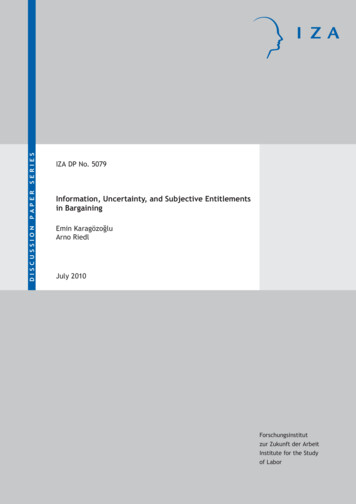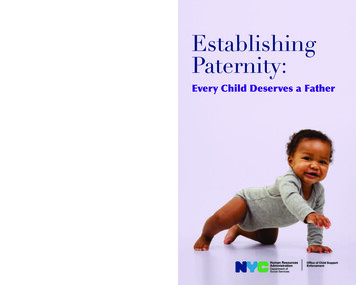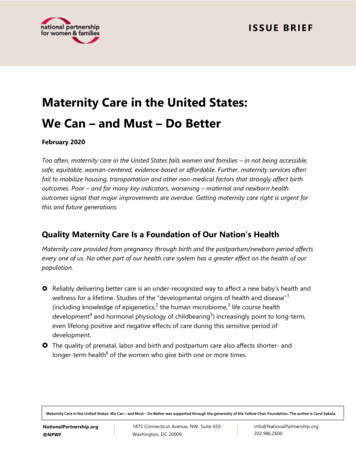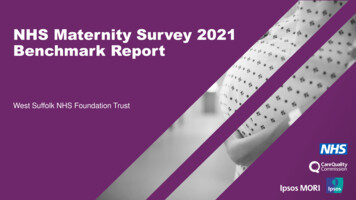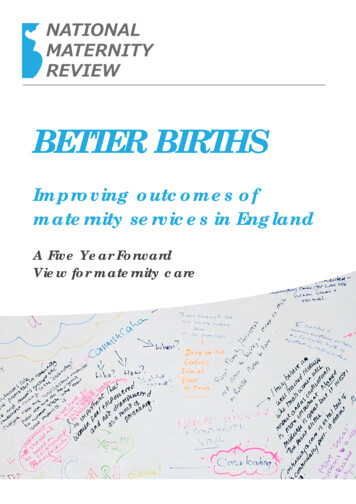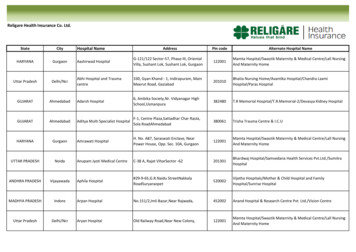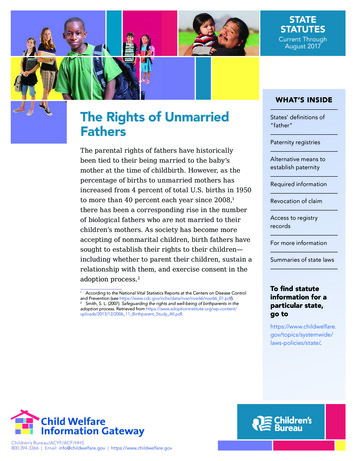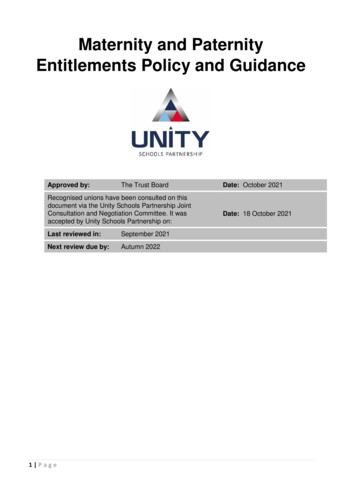
Transcription
Maternity and PaternityEntitlements Policy and GuidanceApproved by:The Trust BoardRecognised unions have been consulted on thisdocument via the Unity Schools Partnership JointConsultation and Negotiation Committee. It wasaccepted by Unity Schools Partnership on:Last reviewed in:September 2021Next review due by:Autumn 20221 PageDate: October 2021Date: 18 October 2021
DOCUMENT CONTROLChanges HistoryIssue NoDateAmended bySummary ofChanges1.0September 2020Head of HRVersion 1.02.0September 2021David ChambersDocument controlpageUpdate to advice insection 2.6 andsection 11Authorisation (Responsible Owner)NameRoleTim CoulsonChief ExecutiveApproval DateApproval (Accountable Owner)NameRoleAngela BullDirector of HRApproval DateReviewers (Consulted)Name and/or RoleApproval DateTrust Executive TeamHeadteachersJCNCDistribution List – Once authorised (Informed)NameMethodAll HeadteachersVia Trust websiteHeadteacher update to share with staffReview PeriodDate Document ReviewedBy WhomNext review - September 2022Trust Executive TeamDirector of HRHeadteachers2 Page
Contents1. Introduction . 52. Maternity Leave . 52.1 Notification of pregnancy . 52.2 Length of maternity leave . 62.3 Ante-Natal Care. 62.4 Sickness Absence and Maternity Leave . 72.5 Contact during maternity leave * . 72.6 Keeping-in-touch (KIT) days during maternity leave . 82.7 Transfer of maternity leave/additional paternity leave/shared parental leave . 82.8 Paternity Leave . 93. Maternity Pay . 93.1 Statutory Maternity Pay (SMP) . 103.1.1 Eligibility . 103.1.2 Rates of SMP . 103.2 Occupational Maternity Pay (OMP) . 113.2.1 Eligibility . 113.2.3 Summary of main benefits . 114. Shared Parental Pay . 124.1 Ordinary Paternity Pay . 125. Employees working under more than one contract . 126. Health & Safety rights for new and expectant mothers . 137. KIT days during shared parental leave . 138. Annual Leave during maternity/shared parental leave . 139. Premature babies . 1410. Late babies. 1411. Stillborn babies & miscarriage . 1412. Return to work after maternity leave . 1412.1 Ordinary maternity leave . 1412.2 Additional maternity/paternity leave . 1512.3 If the employee decides not to return. 1513. Managing requests for flexible working . 1514. Maternity checklist . 1615. Maternity Support Leave . 1616. Fertility Treatment . 1717. Pensions . 1718. Continuous Service . 1719. Protection against discrimination . 183 Page
20. Agency worker regulations and maternity/paternity entitlements . 1821. Glossary of Terms . 1922. Further Advice . 194 Page
1. IntroductionThe purpose of this policy and guidance is to detail the provisions of the maternity and paternityleave and pay provisions, as they apply to Teachers under the Conditions of Service Handbook forTeachers (Burgundy Book) and to Support Staff employed under the terms of the NJC for LocalGovernment Services (Green Book).Open discussion between Headteacher’s, senior leaders or line managers and the employee isencouraged, thereby ensuring that questions or problems are resolved as quickly as possible. Asthe provisions are complex, if an employee becomes pregnant, or their partner is pregnant, theyshould clarify the relevant procedures with their Headteacher, senior leaders, line manager or theTrust's HR Team to ensure that they are followed correctly.2. Maternity LeaveAll pregnant employees can take up to 26 weeks' ordinary maternity leave (OML) and up to 26weeks' additional maternity leave (AML), making a total of 52 weeks. This is regardless of thenumber of hours they work or their length of service. Additional maternity leave begins on the dayafter ordinary maternity leave ends.An employee's entitlement to pay depends on a number of factors, such as length of service andwhether their pay is high enough. The Trust’s HR and Payroll teams are able to explain what theirgeneral entitlements are. If circumstances change, please contact the Trust’s HR and Payroll teamsfor further advice.An employee's rights come partly from statute and partly from their contract of employment.2.1 Notification of pregnancyThe employee is required to give notice that they are pregnant and intends to take maternity leaveno later than the 15th week before the Expected Week of Childbirth (EWC).To qualify for leave under either the occupational or statutory maternity schemes, the employee isrequired to give at least 28 days' notice in writing before they intend to go on maternity leave.However, they may give less than this if they have a good reason for doing so.The notice should be given by completing form MP3. A copy of form MP3 can be provided bycontacting the HR Helpdesk or the relevant HR Business Partner. This notice should state: that the employee is pregnant;the expected week of childbirth (EWC)*the date the employee intends to commence their maternity leave.* The employee should also provide a certificate from a registered medical practitioner or aregistered midwife, known as a MATB1 form, stating the expected week of childbirth, when this isavailable. Both forms should be submitted to the Trust’s HR and Payroll teams.The Trust’s HR and Payroll teams will respond to notification of the employee's leave plans within28 days of their notification, setting out the date on which the employee is expected to return towork in the event of taking their full statutory entitlement to maternity leave (being 52 weeks madeup of OML and AML).The employee can change their mind about the date on which they wish to commence theirmaternity leave by giving at least 28 days' notice of the revised date (unless this is not reasonablypracticable).5 Page
If reasonably practicable, notice of the date the baby was born must be given within 28 days.The starting date of the maternity leave period should normally be agreed between the employeeand their Headteacher, senior leader or line manager. However, the final decision is the employees.The earliest maternity leave can start is 11 weeks before the baby is due, or from the time ofchildbirth if that is earlier. However, if the employee is fit enough, the employee can work right upto the time the baby is due.Normally, maternity leave will commence on the day specified by the employee concerned,although maternity leave can be triggered by pregnancy-related absence (see Section 2.4 Sicknessabsence and maternity leave) or the birth of the baby. When this happens, the maternity leave andmaternity pay period is deemed to have begun on the day following the first day of absence orchildbirth.2.2 Length of maternity leaveThe employee is automatically entitled to a period of 26 weeks' ordinary maternity leave and 26weeks' additional maternity leave, regardless of their hours of work or length of service, where theappropriate notice has been given (see Section 2.1 Notification of Pregnancy). This means theemployee can remain on maternity leave for a total period of up to 52 weeks. The employee mayreceive Maternity Allowance (MA), Statutory Maternity Pay (SMP) and/or Occupational MaternityPay (OMP) during this period, depending on the eligibility criteria being satisfied.An employee need give no further notice of their date of return, unless the employee wishes it tobe earlier than the end of the 52-week (one year) period. In the event of wishing to return to workearlier, the employee must give at least 8 weeks' notice, in the case of support staff, and 21 days'notice for teachers.In cases where the notice given is less than required, a Headteacher, senior leader or line managercan postpone the return to ensure the minimum notice period above, as long as this does not gobeyond the end of the maternity leave period. Where no early or prior notice of a date of return isgiven, the employee will be expected to return to work at the end of the 52-week leave period, asnotified. The Headteacher, senior leader or line manager is expected to notify the Trust’s HR andPayroll teams of the employee's return to work.The Maternity (Compulsory Leave) Regulations 1994 provide that all employees must take aminimum of two weeks' maternity leave immediately after the birth of the child.2.3 Ante-Natal CareOnce an employee has given notice that the employee is pregnant, they will be entitled not to beunreasonably refused paid time off work to attend antenatal appointments as advised by aregistered medical practitioner, midwife or nurse.In order to be entitled to take time off for antenatal care, the employee is required to produce acertificate from their doctor, registered midwife or registered health visitor, stating that they arepregnant (usually the MATB1). Except in the case of the first appointment, the employee shouldalso produce evidence of the appointment, such as a medical certificate or appointment card, ifrequested to do so.Antenatal care may include relaxation and parent craft classes that the employee's doctor, midwifeor health visitor has advised them to attend, in addition to medical examinations. The employeeshould endeavour to give their line manager as much notice as possible of antenatal appointmentsand, wherever possible, try to arrange them as near to the start or end of the working day aspossible.6 Page
From 1 October 2014, employees and agency workers who have a qualifying relationship with apregnant woman or an expected child are entitled to take unpaid time off work to accompany thatpregnant woman at up to two antenatal appointments.Employees will have the right from day one of their employment. Agency workers will qualify after12 weeks in the same assignment. The right to time off is capped at a maximum of six-and-a-halfhours on each occasion, which can include travelling time, waiting time and attendance.An employee or agency worker has a qualifying relationship with a pregnant employee or theirexpected child if they: Are the husband or civil partner of the pregnant employee;Lives with the pregnant employee in an enduring family relationship, but is not their parent,grandparent, sister, brother, aunt or uncle;Is the father of the expectant child; orIs an intended parent in a surrogacy situation who meets certain conditions.Again, the antenatal appointment must be made on the advice of a registered medical practitioner,midwife or nurse. Employees can be asked to provide a signed declaration confirming: theindividual's relationship to the mother or their expected child; the time and date of the appointment;the purpose of the time off; and that the appointment is made on the advice of a registered medicalpractitioner, midwife or nurse.2.4 Sickness Absence and Maternity LeaveIf the employee is absent from work because of a pregnancy related illness on or after the 4th weekbefore the baby is due, this should be treated as the start of maternity leave, unless it is a veryminor illness and the employee is expected to return within 1 or 2 days.If the employee is ill for a non-pregnancy related reason, they will be regarded as being on sickleave until either the baby is born, or the date they have given as the start date of their maternityleave, when they will start receiving their maternity pay.It follows that, if an employee is off sick during or after the 4th week before the baby is due, and theemployee has not started their maternity leave, it is essential that the reason for their absence isidentified quickly. For illnesses where there is uncertainty if the absence is due to pregnancy, whollyor partly, then the advice of the employee's GP and/or an Occupational Health practitioner may beobtained.2.5 Contact during maternity leave *Shortly before an employee's maternity leave starts, you should discuss the arrangements for themto keep in touch during their leave, should they wish to do so. You may reserve the right, in anyevent, to maintain reasonable contact with the employee from time to time during their maternityleave. This may be to discuss the employee's plans for return to work, to discuss any specialarrangements to be made or training to be given to ease their return to work, or simply to updatethem on developments at work during their absence.In order to ensure that the employee is kept updated on developments within the workplace, it isadvisable that either you, or a designated representative, ensure that the employee is forwardedby post, copies of any team meeting notes, job vacancies and/or general information on a regularbasis.* similar planning applies to shared parental leave. For more guidance about paternity leave andshared parental leave, see Section 2.8.7 Page
2.6 Keeping-in-touch (KIT) days during maternity leaveKeeping-in-touch (KIT) days allow an individual to work for up to 10 days (pro-rated for part-timestaff) during their maternity leave, without the risk of statutory maternity leave being terminated.Both parties must be in agreement on any such work and the dates must be mutually agreed. AKIT day cannot take place during the first two weeks following the birth of a child (compulsorymaternity leave).KIT days do not have to be consecutive and can be used for work activities, training or any otheractivity such as a staff meeting, that enables the employee to keep in touch with the workplace. Itis important to note that any hours worked on a KIT day will count as one KIT day, even if only onehour is worked. This means that staff will receive payment for a normal working day regardless ofthe number of hours they have worked on a KIT day.Whilst payment for KIT days (in addition to SMP) is discretionary, the Trust will adopt a consistentapproach, which is usually that the individual is paid their normal rate of pay for KIT hours worked,unless they are coming in to complete a specific task which is outside their normal role and at asignificantly lower level, in which case they should be paid at an appropriate rate (agreed inadvance). If the member of staff is in receipt of OMP or SMP payment for KIT days will be offsetagainst the OMP or SMP as the member of staff cannot earn more than their normal rate of pay.Whatever the decision, this should be clearly discussed with the employee prior to agreeing anyKIT days they attend.The weekly rate of SMP is divisible by 7 to arrive at a daily rate - not by the hours worked to get anhourly rate, or by 5 to represent 5-day weeks.The Trust’s HR and Payroll teams should be sent details of the employee's name, employmentnumber, the hours worked and when they were worked, together with details of how much theyshould be paid, according to your policy. Payroll will calculate the payment due and payment willbe made in the next available payslip. No payment is made for travel or childcare costs.It is the Headteacher's, senior leader’s or line manager’s responsibility to write to the employee,both inviting them to attend a KIT day and/or acknowledging their request to attend a KIT day. It isalso their responsibility to ensure that a record of KIT days the employee has attended is kept.Further information about occupational and statutory maternity pay and maternity allowance areset out in Section 3 of this document.2.7 Transfer of maternity leave/additional paternity leave/sharedparental leaveShared parental leave enables eligible mothers, fathers, partners and adopters to choose how toshare time off work after their child is born or placed. This could mean that the mother or adoptershares some of the leave with their partner, perhaps returning to work for part of the time and thenresuming leave at a later date.The first two weeks of the 52-week entitlement must be taken by the mother or primary adopter,but the remaining 50 weeks' entitlement and pay can be shared or split between both parents, ifthey meet the eligibility criteria. There may also be an entitlement to a maximum of 37 weeks ofshared parental pay. The Trust will apply the same enhanced rate of occupational maternity pay toeligible employees on shared parental leave.8 Page
The Shared Parental Leave policy and guidance is available from the HR Helpdesk,hrhelpdesk@unitysp.co.uk or telephone 01440 333401.2.8 Paternity LeaveOrdinary paternity leaveAn employee whose wife, civil partner or partner gives birth to a child, or who is the biological fatherof the child, is entitled to two weeks' ordinary paternity leave provided that they have 26 weeks'continuous service by the end of the 15th week before the week in which the child is expected.Ordinary paternity leave is also available to adoptive parents where a child is matched or newlyplaced with them for adoption. For more information on adoption rights, please see the separateTrust guidance. Either adoptive parent may take ordinary paternity leave where the other adoptiveparent has elected to take adoption leave. In respect of an adopted child, the employee must have26 weeks' continuous service by the week in which the child's adopter is notified of having beenmatched with the child for adoption.To qualify for ordinary paternity leave, the employee must also have, or expect to have,responsibility for the upbringing of the child and be making the request to help care for the child orto support the child's mother.Ordinary paternity leave must be taken in a single block of one or two weeks within 56 days of thebirth or adoption of the child. If the child is born early, it must be taken from the time of the birth butwithin 56 days of the expected date of childbirth. Ordinary paternity leave can start either from thedate the child is born or placed for adoption or from a chosen number of days or weeks after thatdate.Where an employee wishes to request ordinary paternity leave in respect of a birth child, they mustgive 15 weeks' written notice of the date on which their partner's baby is due, the length of ordinarypaternity leave they wishe to take and the date on which they wish the leave to commence.In the case of an adopted child, the employee must give written notice of their intention to takeordinary paternity leave no later than seven days after the date on which notification of the matchwith the child was given by the adoption agency. The notice must specify the date the child isexpected to be placed for adoption, the date the employee intends to start ordinary paternity leave,the length of the intended ordinary paternity leave period and the date on which the adopter wasnotified of having been matched with the child.If an employee subsequently wishes to change the timing of the ordinary paternity leave, they mustgive 28 days' written notice of the new dates.3. Maternity PayThere are two maternity pay schemes in operation: Statutory Maternity Pay (SMP), which is paid by Payroll on behalf of the Department ofWork and Pensions, andOccupational Maternity Pay (OMP), which is paid by Payroll in accordance with theappropriate National Conditions of Service. Depending on the length of the employee'sservice, they may have entitlement under one or both of these schemes.Entitlement to SMP and OMP are based on relevant continuous service, but cannot, when addedtogether, exceed normal total pay. To make sure this doesn't happen, OMP is offset by SMP.9 Page
3.1 Statutory Maternity Pay (SMP)3.1.1 EligibilityStatutory maternity pay is payable for up to 39 weeks during maternity leave. To get SMP, anemployee must: have been continuously employed by their current employer for at least 26 weeks, at thestart of the 15th week before the baby is due. This 15th week is known as the 'qualifyingweek';have average weekly earnings of not less than the lower earnings limit for the payment ofNational Insurance contributions in the 26 weeks up to and including the 15th week beforethe expected week of childbirth;still be pregnant at the 11th week before the week the baby is due or have had the baby atthat time;have provided medical evidence of the date the baby is due (normally a MATB1 certificate)at least 28 days before the maternity absence is due to start; andhave stopped work.If the employee satisfies these conditions, they qualify for SMP.If an employee is not entitled to SMP, Payroll will issue them with a form SMP1, explaining whythey are not entitled to SMP.If the employee stops work before the qualifying weekThe employee will not normally qualify for SMP if their employment ends before the qualifying week.This is the 15th week before the week in which their baby is due. However, if the employees babyis born prematurely before the QW the employee will be taken as satisfying the continuousemployment rule if they would have been continuously employed but for early childbirth.If the employee stops work during or after the qualifying weekIf employment ends during or after the qualifying week the employee can still qualify for SMP fromtheir former employer.For those who do not qualify for SMP details will also be provided on how they can claim StateMaternity Allowance (SMA) from the Job Centre Plus.3.1.2 Rates of SMPFor the first 6 weeks, SMP is paid at the higher rate, which is equivalent to 90% of the employee'saverage weekly earnings calculated over the period of eight weeks up to and including thequalifying week. For the purpose of calculating average weekly earnings, shift allowances andovertime payments, if applicable, are included.The standard rate of SMP is paid for the remaining 33 weeks, or less if the employee returns towork sooner. SMP is paid at a rate set by the Government (see the gov.uk website) for the relevanttax year, or 90% of the employee's average weekly earnings calculated over the period of eightweeks up to and including the qualifying week, if this is lower than the Government's set weeklyrate.10 P a g e
If the employee becomes eligible for a pay rise between the start of the original calculating periodand the end of their maternity leave (whether ordinary maternity leave or additional maternityleave), the standard rate of SMP will be recalculated to take account of the employee's pay rise,regardless of whether SMP has already been paid. This means that the employee's SMP will berecalculated and increased retrospectively, or that the employee may qualify for SMP if they didnot previously. The employee will be paid a lump sum to make up the difference between SMPalready paid and the amount payable as a result of the pay rise.Statutory maternity pay is treated as earnings and is, therefore, subject to PAYE and nationalinsurance deductions.Payment of SMP cannot start prior to the 11th week before the employee's expected week ofchildbirth. SMP can start from any day of the week in accordance with the date the employee startstheir maternity leave.SMP is payable whether or not the employee intends to return to work after their maternity leave.3.2 Occupational Maternity Pay (OMP)3.2.1 EligibilityTo qualify for OMP, the employee must have at least 1 year of continuous local government serviceat the 11th week before the expected week of childbirth. The Occupational Maternity Pay Schemeapplies to pregnant employees with qualifying service regardless of the number of hours workedper week.If an employee has less than 1 year of continuous local government service at the 15th week beforethe expected week of childbirth, then the employee will not qualify for OMP, but will still get SMPor Statutory Maternity Allowance (SMA) as appropriate.The amount of OMP the individual receives will depend on whether the employee wishes to returnto work. If the employee's baby is born early, before or during the qualifying week and they wouldhave completed 26 weeks' employment but for the early birth, the continuous service rule for OMPis satisfied.In order to determine eligibility for SMP, only continuous service with the Trust, together withprevious unbroken Local Government service with is taken into account.3.2.3 Summary of main benefitsLength of Service OMP AMLLess than 26 weeks at QWAt least 26 weeks atQW but less than 1year at 11 weeksprior to EWC,More than 1 year at11 weeks beforeEWC(Support Staff)More than 1 year at11 weeks beforeEWC11 P a g e SMPNo entitlementexcept possiblySMA6 weeks at 90% ofaverage pay plus 33weeks standard rateSMP6 weeks at 90% ofaverage pay plus 33weeks standard rateSMP6 weeks at 90% ofaverage pay plus 33OMPNo entitlementNo entitlementWeeks 1-6 as per SMP Weeks 7-18half pay (unless half pay plusstandard rate SMP exceeds normalpay) *Weeks 1-4 full pay Weeks 5-6 asper SMP Weeks 7-18 half pay
(Teachers)weeksSMPstandardrate (unless half pay plus standard rateSMP exceeds normal pay)**Note that if the normal earnings are lower than the standard rate of SMP, but above the LowerEarnings Limit (LEL), the 33 weeks will be paid at 90% of normal earnings.* Support Staff are required to return to work (technically to "local authority employment" meaningthat school-based support staff can return to another school or local authority without having torepay their OMP) for a minimum of 3 months to secure an entitlement to OMP. If they do not, thenthe half pay entitlement must be repaid (SMP is not refundable). They may choose to have the halfpay paid as it falls due, as a lump sum on return to work or as a lump sum after they have returnedto work for three months.** Teachers are required to return to work (technically to the same job in the same school, inaccordance with the Burgundy Book) for a minimum period of 13 weeks (or pro rata equivalent ifthey reduce working hours on their return to work) to secure an entitlement of OMP. If they do not,then the half pay entitlement must be repaid (SMP is not refundable). The employee may chooseto have the OMP paid as it falls, as a lump sum on return to work or as a lump sum after they havereturned to work for three months.Please note that employee must return to contracted work in order to secure the entitlement toOMP. Supply and casual contracts do not count as contracted work.4. Shared Parental Pay4.1 Ordinary Paternity PayPay during ordinary paternity leave will be at a standard rate of Statutory Paternity Pay (SPP) setby the Government for the relevant tax year, or at a rate equivalent to 90% of the employee'saverage weekly earnings if this figure is less than the rate of SPP. However, employees whoseaverage weekly earnings are below the lower earnings limit (LEL) for national insurancecontributions will not be eligible
practitioner, midwife or nurse. 2.4 Sickness Absence and Maternity Leave If the employee is absent from work because of a pregnancy related illness on or after the 4th week before the baby is due, this should be treated as the start of maternity leave, unless it is a very minor illness and the employee is expected to return within 1 or 2 days.

